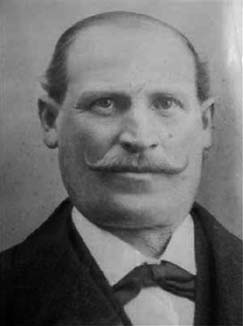

تاريخ الرياضيات

الاعداد و نظريتها

تاريخ التحليل

تار يخ الجبر

الهندسة و التبلوجي


الرياضيات في الحضارات المختلفة

العربية

اليونانية

البابلية

الصينية

المايا

المصرية

الهندية


الرياضيات المتقطعة

المنطق

اسس الرياضيات

فلسفة الرياضيات

مواضيع عامة في المنطق


الجبر

الجبر الخطي

الجبر المجرد

الجبر البولياني

مواضيع عامة في الجبر

الضبابية

نظرية المجموعات

نظرية الزمر

نظرية الحلقات والحقول

نظرية الاعداد

نظرية الفئات

حساب المتجهات

المتتاليات-المتسلسلات

المصفوفات و نظريتها

المثلثات


الهندسة

الهندسة المستوية

الهندسة غير المستوية

مواضيع عامة في الهندسة

التفاضل و التكامل


المعادلات التفاضلية و التكاملية

معادلات تفاضلية

معادلات تكاملية

مواضيع عامة في المعادلات


التحليل

التحليل العددي

التحليل العقدي

التحليل الدالي

مواضيع عامة في التحليل

التحليل الحقيقي

التبلوجيا

نظرية الالعاب

الاحتمالات و الاحصاء

نظرية التحكم

بحوث العمليات

نظرية الكم

الشفرات

الرياضيات التطبيقية

نظريات ومبرهنات


علماء الرياضيات

500AD

500-1499

1000to1499

1500to1599

1600to1649

1650to1699

1700to1749

1750to1779

1780to1799

1800to1819

1820to1829

1830to1839

1840to1849

1850to1859

1860to1864

1865to1869

1870to1874

1875to1879

1880to1884

1885to1889

1890to1894

1895to1899

1900to1904

1905to1909

1910to1914

1915to1919

1920to1924

1925to1929

1930to1939

1940to the present

علماء الرياضيات

الرياضيات في العلوم الاخرى

بحوث و اطاريح جامعية

هل تعلم

طرائق التدريس

الرياضيات العامة

نظرية البيان
Louis Puissant
المؤلف:
J J OConnor and E F Robertson
المصدر:
J J OConnor and E F Robertson
الجزء والصفحة:
...
8-7-2016
579
Born: 22 September 1769 in Champagne, France
Died: 10 January 1843 in Paris, France

Louis Puissant's family were farmers from the Champagne region of France. Louis trained as a land-surveyor but felt that he did not know enough mathematics to carry out this work to the standard that he wished, so decided that he must study geometry. He made rapid progress with his studies, showing that he hadreal talent for the subject.
He was employed in the French War Department in 1790, then, beginning in 1792, he became an engineer-geographer with the French army in the Eastern Pyrenees and in Spain. He returned to Paris in 1796 where he was appointed professor at the École Centrale d'Agen. In 1802 he was promoted to engineer-geographer first class. He was sent to the Island of Elba to carry out triangulations there, then after this was sent to Lombardy to carry out a similar task. This was a time when the French were undertaking many projects measuring the earth. Much of this was related to the introduction of the metre which had become obligatory throughout France in 1801. Delambre and Méchain had been measuring the meridian since 1792 and this project was still not complete when Puissant was carrying out triangulations using similar methods. Puissant was fascinated by this major scientific project, and wrote an book on the problem of the shape of the earth.
He was professor of mathematics at the École Centrale de Lot-et-Garonne, then at the military academy at Fontainebleau. He directed the École de Géographes in Paris from 1809 to 1833. These were difficult years during which Napoleon rescinded the metric system in France, then suffered a military defeat with his Russian campaign in 1812, and was finally defeated in 1815. The Bourbons' constitutional monarchy fell in 1830 and revolutions led to fighting in the streets of Paris. Puissant had risen to the rank of lieutenant-colonel by the time he left the army.
On 3 November 1828 Puissant was elected to the Academy of Sciences to fill the vacancy caused by the death of Laplace in the previous year.
He is best remembered for his invention of a new map projection for a new map of France, and he was involved in the production of the map. The map was produced with considerable detail, the projection used spherical trigonometry, truncated power series and differential geometry.
Puissant wrote on geodesy, the shape of the earth and spherical trigonometry. He wrote a mathematics text Cours de Mathématiques. In 1801 he published Recueil de diverses propositions de Géométrie, résolues ou démontrées par l'analyse algébrique, suivant les principes de Monge et de Lacroix: à l'usage de ceux qui suivent le traité Elémentaire d'Application de l'Algèbre à la Géométrie de ce dernier. In 1807 he published Traité de topographie, d'arpentage et de nivellement. A second enlarged edition was produced in 1820. A supplement to this work contains his theory of map projections.
Article by: J J O'Connor and E F Robertson
August 2006
 الاكثر قراءة في 1750to1779
الاكثر قراءة في 1750to1779
 اخر الاخبار
اخر الاخبار
اخبار العتبة العباسية المقدسة

الآخبار الصحية















 "المهمة".. إصدار قصصي يوثّق القصص الفائزة في مسابقة فتوى الدفاع المقدسة للقصة القصيرة
"المهمة".. إصدار قصصي يوثّق القصص الفائزة في مسابقة فتوى الدفاع المقدسة للقصة القصيرة (نوافذ).. إصدار أدبي يوثق القصص الفائزة في مسابقة الإمام العسكري (عليه السلام)
(نوافذ).. إصدار أدبي يوثق القصص الفائزة في مسابقة الإمام العسكري (عليه السلام) قسم الشؤون الفكرية يصدر مجموعة قصصية بعنوان (قلوب بلا مأوى)
قسم الشؤون الفكرية يصدر مجموعة قصصية بعنوان (قلوب بلا مأوى)


















